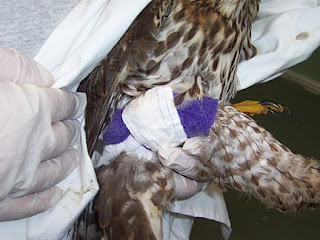...back to our regularly scheduled blogging! Much has happened in the last 3 weeks, so let's get right to it, shall we?
Look at this GORGEOUS bird we got in! 
Unfortunately, swans have a love of all things shiny and a good majority of the ones we see are suffering from lead poisoning due to eating lead buckshot or lead fishing weights. By the time we get them, it's too late to do anything for them. Serena, who helped out while our other rehabber was on vacation, said that in all the years she has worked there they have only had one swan that has survived to be released. This one didn't make it through the night.
We actually had a total of 3 swan patients in the last couple of weeks. We found a Trumpeter swan that was emaciated and it died the same day and another one hit the power lines near a pond they tend to congregate in and died before they could get to it. I am sure healthy birds can misjudge distances, but lead poisoning affects the neurological system of the birds first and therefore their eyesight can deteriorate enough for them to do that as well. Our city actually installed fluorescent hanging "tags" from these very same power lines to try and make them more visible to the swans, as these power lines are located along known flight paths of the swans when they come in to land on nearby ponds.
This is the one animal that we get in that seems so strong, yet at the same time so vulnerable, that I just want to cradle them in my arms and WILL them to get better. If only it was that easy.
We had a Barred owl come in and I actually did the intake exam on it, with a lot of encouragement and help from Serena (Thanks for your patience with me Serena!).
We gave him some sub-q fluids and then gave him a homeopathic medicine for stress. He had to be force fed for a few weeks and everyone I talked to said they had never had to deal with a bird that was so difficult to force feed before. The next week, when we had to force feed him, I made a quip about needing a wedge of wood to help keep his beak open, but a Q-tip ended up doing the trick and made the feeding job a LOT easier! And it turns out that his "sleepy" behavior is just how his body handles stress.
He is doing just great now and last week we moved him to the slatted flight cage for some flying practice!



When I came in last week and inquired about him, I was told that as of that previous Tuesday he still wasn't standing and they were considering euthanizing him. That is until Nikki, our rehabber, went in on Wednesday to examine him and he taloned her!
Our other Cooper's hawk story is another one of those "What the HELL, people?!" stories. He was found on Orcas Island and was unable to stand. Upon examination and subsequent x-raying, it was discovered that someone had shot him! Again, people, if you are so bored and stir crazy living on the islands that you feel the need to shoot at anything that moves, it's time to move to the mainland!
The buckshot pellet had fractured his right femur and shattered one end into a couple of pieces. He underwent 3 hours of surgery and what they did was fascinating! They pinned his little leg. They ran pins along the bone, pinning the bone ends internally, and out either end of his femur. They then made a crossbar and attached it at one end along the two pin ends to keep the whole thing stabilized. Then the whole thing was wrapped up. At least I THINK that's what they did, if I understood it correctly as it was explained to me.

And last but not least was this interesting and very puzzling case we had with a Glaucous-winged gull we got brought to us on Saturday. A gentleman found him high up on a beach, unable to fly, and it was making these terrible gasping noises. It sounded to me like he was having problems breathing, like something was caught in his trachea or gullet. Nikki said it sounded like it was dying and sure enough it did during our examination. We finished examining it and could find nothing wrong with it from outward appearances. It wasn't even thin. So we decided to x-ray it to see if there was something going on internally that we couldn't see or feel.
...absolutely nothing! No broken bones, nothing stuck in his crop or trachea...nothing! So we then decided to necropsy it as a final push at determining what had caused its demise. And guess what? He had NO LUNGS!!! I am serious people. We found some yellow grainy, infectious looking bits but that was it! We followed the trachea past the breastbone to about the liver and it veered off into air sacs but we didn't even see where the branches were that should have gone TO the lungs! We were so confused by the whole thing we even went to look at an avian anatomy book to make sure we were, well, NOT seeing what we WEREN'T seeing. It was VERY bizarre!
That's it for now. I joined the 21st century and got DSL, so I will be posting more regularly, as it was just getting too frustrating posting without it, hence the long lag time between postings.
Til next time...
Thursday, December 28, 2006
And now......
Posted by
Heather
at
7:14 PM
3
comments
![]()
![]()
Subscribe to:
Comments (Atom)

